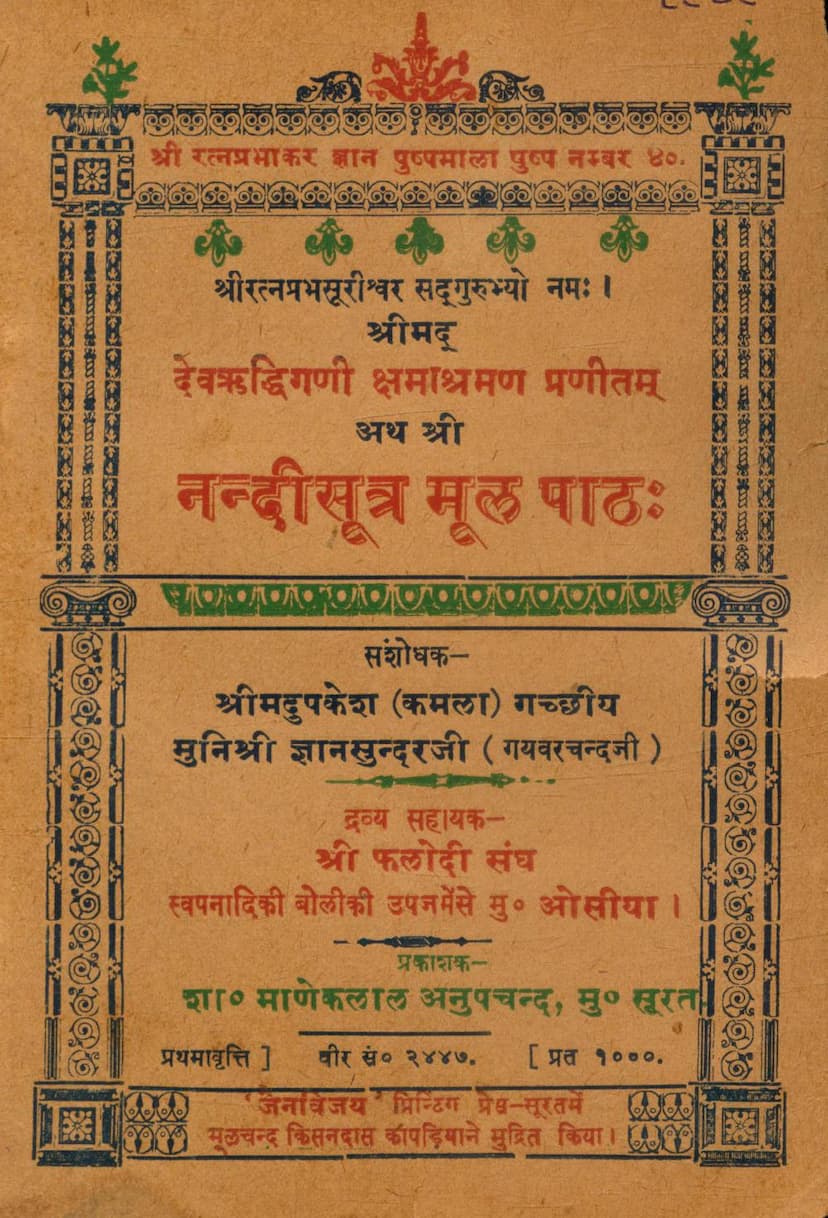Nandisutra Mahatmya
Added to library: September 2, 2025

Summary
This document is the Nandisutra Mahatmya (Glory of the Nandisutra), authored by Gyansundar. Published by Shah Maneklal Anupchand in Surat, it is the first edition, printed in Veer Samvat 2447 (1910/1911 CE) with an edition size of 1000 copies. The text is presented as part of the "Shri Ratna Prabhakar Gyan Pushpamala" series, specifically as issue number 40.
The introductory pages (Pages 3-4) of the Mahatmya section highlight the profound importance and auspiciousness of the Nandisutra. It is described as:
- A treasury of knowledge: The source of the twelve Angas (limbs) of Jain scripture, revealed by Lord Mahavira.
- The essence of Syadvada: The core of the Twelve-limbed doctrine (Dvadasangi Vani).
- An ideal of eternal order: Representing the truth of all three periods (past, present, future).
- A guiding light: Dispelling darkness and ignorance.
- A remover of sins and calamities.
- The lifeblood of all beings.
- The embodiment of the soul of knowledge.
The text emphasizes that the Nandisutra was compiled by the venerable Muni Shri Gyansundarji and was a work of devotion and service to the Sangha (community). It asserts that studying the Nandisutra leads to liberation and enjoyment in both worlds, and that ancient great souls would engage in their daily sustenance only after reciting the Nandisutra.
The Mahatmya further elaborates on the benefits of reciting the Nandisutra:
- Destroys karmic obstructions: Leading to the destruction of knowledge-obscuring karma and other karmas.
- Enhances intellect and memory: Improving intelligence, memory power, comprehension, and intuition.
- Cleanses the mind and body: Purifying the brain, removing physical ailments, and promoting mental focus.
- Awakens inner potential: Activating the Kundalini and blossoming the navel lotus.
- Strengthens various faculties: Boosting willpower, knowledge, merit, righteousness, health, self-control, character, austerity, mental fortitude, speech, physical strength, action, study, heart, scripture, and meditative power.
- Purifies negative tendencies: Eliminating negative impressions and attracting divine energies.
- Grants auspicious visions: Bestowing good dreams, divine signs, and visions of ancient sacred sites.
- Invites divine grace: The deity of the sutra becomes favorable and bestows good counsel at every moment.
The Mahatmya strongly encourages the daily recitation of the Nandisutra, either once or twice, with a vow, stating that its practice continues to manifest miraculous results. It is described as a gem in the fifth era, with each letter imbued with mantra-like potency. The text concludes with a plea to all virtuous souls to diligently study the Nandisutra, as "Swadhyaya param tapah" (Study is the greatest austerity).
Following the Mahatmya, the document presents the original text of the Nandisutra (Page 5 onwards), which is a series of invocations and salutations. This section includes:
- Praise for Lord Mahavira, highlighting his role as the world's savior, source of joy, protector, kinsman, and beloved ancestor (verses 1-3).
- Salutations to the Jain Sangha, described with numerous auspicious attributes such as a beacon of virtue, a repository of gems, pure in vision, adorned with unbroken conduct, and a refuge (verses 4-11).
- Further elaborate descriptions of the Sangha's glory, using metaphors of mountains, celestial gardens, and precious jewels (verses 12-18).
- A list of the 24 Tirthankaras, from Rishabhadeva to Mahavira (verses 19-21).
- A list of the chief disciples (Ganadharas) of Lord Mahavira, including Indrabhuti, Agnibhuti, Vayubhuti, Vyaktaswami, Sudharmaswami, Mandraputra, Akampita, Jatayu, and Prabhasa (verses 22-23).
- Praise for the victory of the Jain teachings over wrong beliefs and the triumph of Lord Mahavira's doctrine (verse 24).
- Salutations to prominent Jain scholars and Acharyas from various lineages, extending to many pages, detailing their virtues and contributions to the Jain tradition (verses 25-50). This section includes a detailed enumeration of the eleven Angas of Jain scripture, discussing their contents, classifications, and significance.
The latter part of the document delves into the classification and details of various types of knowledge as described in Jain philosophy, specifically:
- Prakshi (Perceptible) and Paroksha (Imperceptible) knowledge: Further elaborating on sensory and non-sensory perception.
- Avadhi knowledge (clairvoyance): Explaining its origin, types, scope, and progression.
- Manaparyaya knowledge (telepathy): Discussing its manifestation in humans, its limitations, and its classification.
- Kevala knowledge (omniscience): Describing its various stages and its ultimate nature.
- Matikrama (mind-based knowledge) and Shrutakrama (scriptural knowledge): Differentiating and explaining the nuances of these two forms of knowledge.
- The twelve Angas of Jain scripture are systematically described, with each Anga's content, structure, and importance being detailed. This includes discussions on categories of souls, karma, spiritual progress, and the teachings of the Tirthankaras.
The document concludes with a section titled "Nandi Sammatta" (The Sammatta of Nandi), indicating the completion of the Nandi Sutra's presentation.
The final pages (Pages 59-60) contain a note by Muni Gyanasundarji regarding variations in the stanzas (gathas) of the Nandisutra found in different ancient texts. He points out discrepancies in the number of stanzas and suggests possible reasons for these differences, inviting scholarly clarification. It also lists other books published by the "Shri Ratna Prabhakar Gyan Pushpamala" series.